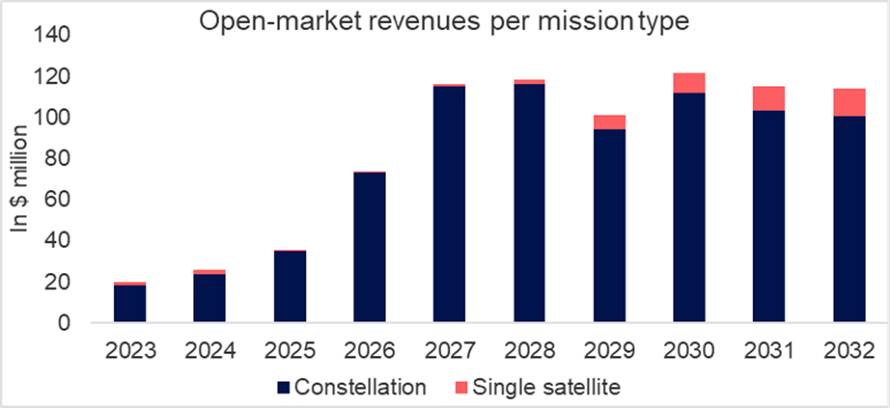From RF to RF-over-IP to cloud and lasers, functions that once only used to happen in “ground” systems are coming to be spread out across space and cyberspace as well.
A recent report by Novaspace (formerly Euroconsult) predicts the optical terminal NGSO constellation market will grow to some $800 million in the next decade, and that optical connections between those satellites and between satellites and terminals on the ground will be a key part.
 Projected market revenues by mission type from Novaspace’s 2024 Optical Communications Market report. (Source: Novaspace)
Projected market revenues by mission type from Novaspace’s 2024 Optical Communications Market report. (Source: Novaspace)
While analysts are not predicting laser will replace traditional RF space-to-ground operations broadly, there are considerable advantages to be had, such as high transport rates and increased security. As with other types of connectivity, interoperability will magnify value. For example, what if communications could go up over Starlink and come down over Kuiper? Or mPower, or a GEO constellation, especially to service congested areas?
Defense and other government agencies are particularly interested in lasers for their own reasons, for example, the possible ability to interoperate between communications and Space Domain Awareness (SDA) and related sensors. “Inter-” being the operative prefix.
The other SDA, the U.S. Space Development Agency, has an acute interest in these systems, so they created their Optical Communications Terminal (OCT) standard in 2020 to provide, “interface specifications that enable space vehicles and payloads developed and operated by multiple organizations to readily exchange data via optical.”
However, Novaspace also reports the recurrence of a challenge that plagued IP and RF technology-- proprietary infrastructure that challenges interoperability. “Over the next decade, Laser Communications Terminals (LCT) are anticipated to be internally developed, thereby creating their own standards, by existing Non-Geostationary Orbit (NGSO) constellation operators such as SpaceX’s Starlink, Amazon’s Kuiper and Guowang,” says Novaspace.
OCT, which is now in rev 3.1, may have an advantage over other standards efforts since the military is one of the world’s leading buyers of inter-satellite links. Does it have enough muscle to force compliance to a specific standard in a global commercial market? If Starlink, et. al., want that government business, it may have to adapt, assuming the government sticks to its guns. And will a standard for the government necessarily spill over into a commercial market standard?
